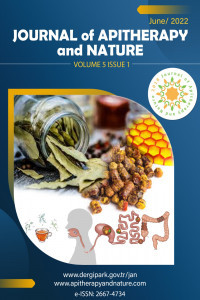The Characterization and Bioactive Composition of Turkish Propolis
The Characterization and Bioactive Composition of Turkish Propolis
Turkish propolis, Bioactive Composition,
___
- .
- Yayın Aralığı: Yılda 2 Sayı
- Başlangıç: 2018
- Yayıncı: Oktay YILDIZ
Phenolic Compounds of Spain Propolis
Félix ADANERO-JORGE, M Camino GARCÍA-FERNÁNDEZ, Rosa M VALENCIA-BARRERA, J. Javier SANZ-GÓMEZ
Efrain ALDAY, Lucía URIBE, Dora VALENCIA, Adriana GARIBAY-ESCOBAR, Anna Lisa PICCINELLI, Luca RASTRELLI, Humberto ASTIAZARÁN-GARCÍA, Ramón Enrique ROBLES-ZEPEDA, Javier HERNANDEZ, Carlos VELAZQUEZ
Soumaya TOUZANI, Sleman KADAN, Abdalsalam KMAIL, Bashar SAAD, Badiaa LYOUSSI
Toothpaste with Propolis “Apident” Shows Antimicrobial Activity in vitro
Klemen RIHAR, Dunja Gregorič EXEL, Adriana PEREYRA, Rok KOPINČ, Bratko FILIPIČ
Propolis: A Natural Product – Great Potential as a Medicine
The Effect of Propolis on Selected Blood Parameters of Broilers
İvan MISKULIN, İvana KLARIC, Matija DOMACINOVIC, Berislav PRAKATUR, Zvonimir STEINER, Vatroslav SERIC, Maja MISKULIN
Antioxidant Activities of Propolis from Aragón (Spain)
M. Teresa SANCHO, Sandra M. OSÉS, Andrea RODRÍGUEZ-FERNÁNDEZ, Miguel A. FERNÁNDEZ-MUIÑO, Consuelo PÉREZ-ARQUILLUÉ, Regina LÁZARO, Susana BAYARRI
Determination of Phenolic Acids in Raw Propolis Using Near Infrared Spectroscopy
Ana María VIVAR-QUINTANA, İsabel REVILLA, María İnmaculada GONZÁLEZ-MARTÍN, Eddy Valentín BETANCES-SALCEDO
Bíliková KATARÍNA, Yamaguchi YOSHIHISA
İsamara Julia CAMURI, Adriano Batista COSTA, Wallance Moreira PAZIN, Amando Siuiti ITO
